

Vol. 40 (Number 20) Year 2019. Page 29
KSENOFONTOVA, Tatyana Y. 1; BEZDUDNAYA, Anna G. 2; SMIRNOV, Roman V. 3; PROKOPENKOV, Sergei V. 4; KHOMICHEV, Evgenii A. 5 & PASHINA, Marina A. 6
Received: 28/03/2019 • Approved: 03/06/2019 • Published 17/06/2019
ABSTRACT: The aim of the research presented in this article is an assessment of the results achieved over the first two years of implementation of the Federal Law no. 119 adopted in 2016. Within the framework of the law, the program known to the population of Russia as the “Far Eastern hectare” was developed. In accordance with the program, every citizen of the Russian Federation has the right to apply for receipt of a free land plot in the Far East. Based on the analysis of the statistical data on the number of submitted and fulfilled applications for receipt of a land plot, the quality of the provided land, intentions regarding the usage of received land plots, geography of the received plots and places of permanent residence of applicants, developed a system of business plans for organization of startups on the Far Eastern hectares, and synthesis of the feedback presented by the first participants of the program on its official website, which have been conducted by the authors, conclusions about the character and quality of events carried out under the above-mentioned program are made. Besides, the authors suggest key directions for the development of the “Far Eastern hectare” program, which should be followed in the future in order to increase the efficiency of its practical implementation. |
RESUMEN: El objetivo de la investigación presentada en este artículo es una evaluación de los resultados alcanzados durante los primeros dos años de implementación de la Ley Federal no. 119 adoptado en 2016. En el marco de la ley, se desarrolló el programa conocido por la población de Rusia como la "hectárea del Lejano Oriente". De conformidad con el programa, todos los ciudadanos de la Federación de Rusia tienen derecho a solicitar la recepción de una parcela de tierra gratuita en el Lejano Oriente. Basado en el análisis de los datos estadísticos sobre el número de solicitudes presentadas y cumplidas para la recepción de un terreno, la calidad del terreno proporcionado, las intenciones con respecto al uso de los terrenos recibidos, la geografía de los lotes recibidos y los lugares de residencia permanente de los solicitantes desarrollaron un sistema de planes de negocios para la organización de nuevas empresas en las hectáreas del Lejano Oriente y sintetizaron los comentarios presentados por los primeros participantes del programa en su sitio web oficial, realizados por los autores, conclusiones sobre el carácter y la calidad. de los eventos realizados en el marco del programa mencionado. Además, los autores sugieren direcciones clave para el desarrollo del programa de "Ha de Extremo Oriente", que debe seguirse en el futuro para aumentar la eficiencia de su implementación práctica. |
In 2016, the Federal Law no. 119 known among the population of Russia as “the law about Far Eastern hectare” was adopted in order to regulate legal relations connected with the transfer of land plots located in the Far Eastern Federal District (FEFD) to citizens of Russia.
In accordance with the indicated federal law a program has been developed, within which every citizen of the Russian Federation has the right to apply for receipt of a land plot of up to one hectare located in the Far East and owned by the state or municipality and use it according to the designated purposes specified in the Federal Law no. 119 at no charge for the following five years. In the future, this citizen will get an opportunity to register the land plot under their ownership or long-term rent.
There are plenty of free territories in this region, and it might seem tempting to get a whole hectare for living or farming, especially for free. Is this initiative beneficial for participants of this program? In this article, the issue is considered from the perspective of the government, which initiated the program, and from the point of view of ordinary citizens, for whom it has been developed.
Now, when it has been over two years since the Federal Law no. 119 under examination came into effect, relying on the results of the conducted analysis of the data described above and the conclusions drawn, we have developed a system of key directions for further development of the “Far Eastern hectare” program that should be followed in order to increase the effectiveness of its practical implementation both for each participant and the country in general.
The hypothesis of the research is our opinion, according to which, the program of formation of new settlements in the Far East due to allocating free hectares to Russian citizens is another attempt to improve the demographic dynamics in the FEFD statistically undertaken by the Government of the Russian Federation, which was invented after the statement of the fact that the progress of priority development areas (PDAs) in the Far East is not showing the expected socio-economic result and the problem of increasing the density of economic activity in Far Eastern territories is not being solved within the scheduled time frames. By now, the “Far Eastern hectare” program has proved its significance as a real contribution to the process of territorial development. However, to increase the level of attractiveness of this program for ordinary citizens, it is necessary to take a а few measures oriented towards improving the program provisions, including expanding the range of support provided by the government. Otherwise, it can be expected that the main settlers in the Far Eastern territories will be oligarchs, who will use the allocated land plots in the “high-demand territories” as recreational and entertainment areas for a limited number of clients.
Analysis of the main provisions of the Federal Law no. 119 FZ “On the specific features of providing to citizens land plots in state or municipal ownership and located or municipal ownership and located in the territories of subjects of the Russian Federation that are part of the Far Eastern Federal District and on amending certain legislative acts of the Russian Federation” of May 1, 2016 (latest revision) (Federal Law № 119-FZ, 2016) and statistical data regularly updated on the website “Far Eastern hectare: A social initiative of the Government of the Russian Federation” (2016) illustrate the scheme and the first results of the provision of land plots in the Far East to Russian citizens. However, we did not manage to find any research papers devoted to the analysis and assessment of the first results of the implementation of the “Far Eastern hectare” program in available sources. Scientific works on the regional economy are quite widely represented though; models of formation of new settlements in newly developed territories are represented in the paper mentioned in the references at the end of this article (Ksenofontova, Kocheleva, Bezdudnaya, 2016)
We believe that we have achieved the aim of the paper, which consisted in the assessment of the results achieved over the first two years of implementation of the Federal Law no. 119 adopted in 2016 and known among the population of Russia as “the law about Far Eastern hectare” since the article contains general and specific conclusions about the character and quality of events carried out under the above-mentioned program.
Besides, we suggest key directions for the development of the “Far Eastern hectare” program, which should be followed in the future in order to increase the efficiency of its practical implementation.
“Each citizen of Russia has the right to receive a land plot of up to one hectare in the Far East” — this is the opening phrase on the official website of the state program “Far Eastern hectare” (2016).
In order to analyze the first results achieved in the course of implementation of the Federal Law no. 119, we studied the feedback provided by actual participants of the “Far Eastern hectare” program on the official and other websites created by program participants specially for opinion exchange purposes.
Based on the statistics gathered by the Ministry for the Development of the Russian Far East (Ministry for the development of the Far East, n.d.), we collected the necessary information about the plans of program participants regarding future usage of the received land plots.
For the purpose of aiding potential entrepreneurs in rendering their business ideas into the form of ready business plans, a contest was held on the official website, the ultimate goal of which was to identify the best ideas of using the Far Eastern territories. By the end of 2018, about 40 project solutions for land plot development were presented on this website, the potential economic effect of which is estimated at the level from 100,000 to 30,000,000 rubles.
In the course of the research described in this article, we came up with conclusions and recommendations presented below, relying on the analysis of the statistical data on the number of submitted and fulfilled applications for receipt of a land plot, the quality of the provided land, intentions regarding the usage of received land plots, geography of the received plots and places of permanent residence of the applicants, developed a system of business plans for organization of startups on the Far Eastern hectares, and synthesis of the feedback presented by the first participants of the program on the official website of the program.
The law about Far Eastern hectare appeared under the influence of two factors. First, it is aimed at developing the Far East: the population of this region is reducing as a result of migration outflow to other regions of Russia (Figure 1). The only area showing a natural increase in the region is Yakutia.
Figure 1
Population dynamics in the FEFD, 2010–2018
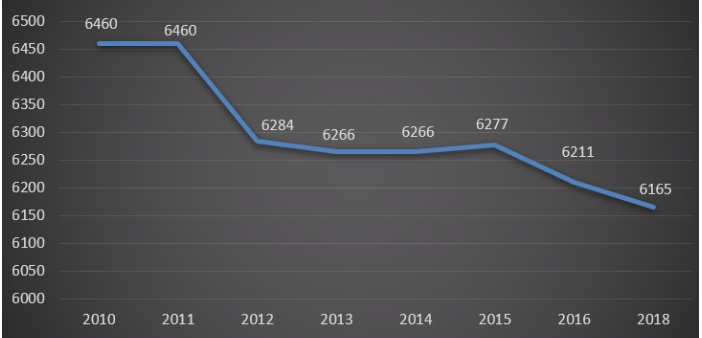
Second, such a large-scale state project is not just a point of growth, but one of the prospective growth areas for the national economy in general. However, in the course of implementation of such large-scale projects in Russia, it is necessary to establish serious state control over the usage of investment resources in order to eliminate the possible corrupt practices among the government officials involved in this program (Bezdudnaya, Smirnov, 2017).
Adoption of this legislative act was a result of a several years’ work conducted by the Ministry for the Development of the Russian Far East, the aim of which was to develop a plan for the development of the above-mentioned territories.
In order to analyze the first results achieved in the course of the implementation of the Federal Law no. 119, we studied the feedback provided by actual participants of the “Far Eastern hectare” program on the official and other websites created by program participants specially for opinion exchange purposes. Analysis of video reviews allows identifying the following problems specified by the first program participants.
Actual reviews provided by participants can be used to specify the following problems:
Also, the problem of rejection of applicants willing to take part in the program is often mentioned. Such rejections can be caused by the following reasons:
The applicants lead active discussions in various Internet communities devoted to both the program and the methods of its implementation. In particular, a few methods allowing any person participating in the “Far Eastern hectare” program to expand their opportunities are indicated:
After reviewing the feedback provided by the first participants of the program and new applicants, as well as the official statistics presented on the website of the Ministry for the Development of the Russian Far East, the gathered information can be summarized. The corresponding results and conclusions classified according to the results are presented in Table 1.
Table 1
The identified key characteristics of the “Far Eastern hectare” program
Key characteristics of the “Far Eastern hectare” program |
|
1. Negative aspects of the first experience gained in the course of implementation of the Federal Law no. 199 FZ |
- lack of developed infrastructure in the remote areas of the FEFD; - impossibility of remote closing of the deals related to transfer of land; - land plots assigned for usage by citizens within the program are sometimes not suitable for most purposes indicated in the federal law; - technical problems found in the course of cadastral registration of land plots assigned for the program according to the federal law. |
2. Positive aspects of the first experience gained in the course of implementation of the Federal Law no. 119 FZ |
- the opportunity to receive a land plot for usage at no charge; - availability of the procedure of applying for participation in the program for all citizens of the Russian Federation; - introduction of a few “accompanying” programs aimed at subsidizing the participants, providing them with various benefits, etc.; - ensuring efficient use of undeveloped lands in the Russian Federation. |
3. Planning of land plot usage by participants of the “Far Eastern hectare” program |
Most program participants (about 78%) are people who plan to use the received land plots for residential or farming purposes. |
Analysis of the information summarized in Table 1 allows making the following conclusion: the “Far Eastern hectare” program is quite viable, people show sufficient interest in it on a nationwide scale. However, the implementation of this program is encumbered with a few problems.
Besides, apart from positive aspects, many participants have pointed out several common drawbacks of the program including the following:
Corrupt practices were mentioned by the participants of the “Far Eastern hectare” program in connection with the scheme of land plot distribution. They noted that on the very first day of registration when the website was not working yet, there were some “lucky guys” who managed to register their land plots in Primorsky Krai on the shores of the Khanka lake. Therefore, by the second day of the website operation, the whole coastline had already been occupied. Interestingly, among these land plots, there was a plot assigned to a group of people resulting from a so-called “collective application”. A few program participants assumed that on the first day of the program some people used the opportunity to get a bigger land plot due to the incorporation of “ghost participants” into their application. Such promptness on the day when booking of a land plot via the website was impossible unambiguously suggests the involvement of corrupt practices in this scheme.
Having studied the feedback posted on the Internet, we noticed that a few program participants complain about lengthy periods of processing of their applications and presence of several land plots unsuitable for any potential usage, such as mountainous or swampy terrains, in the register of assigned land plots. Many of the suggested territories are protected by the law: hunting areas, conservation areas and other restricted territories.
Except for the above-mentioned situation connected with filing collective applications, many program participants point out the availability of the collective application option as a positive opportunity, which eliminates some serious problems in the formation of the infrastructure for future settlements (Bezdudnaya, Loginov, 2018). A collective application can be filed by a group of at least ten citizens. Taking into consideration that each citizen is eligible for receiving a land plot of up to one hectare, 12 citizens can apply for 12 hectares of land in their collective application. In this case, the group of like-minded people receive a larger land plot to accomplish their business ideas, i.e. to develop private entrepreneurship in the FEFD. Besides, when it comes to collective applications, the government covers the costs of organizing infrastructure, namely construction of access roads and communication lines (Ksenofontova, 2013b).
For the purpose of aiding potential entrepreneurs in rendering their business ideas into the form of ready business plans, a contest was held on the official website of the program, the goal of which was to identify the best ideas of using the Far Eastern territories. By the end of 2018, about 40 project solutions for land plot development were presented on this website, the potential economic effect of which is estimated at the level from 100,000 to 30,000,000 rubles. In the future, it is recommended to attract the intellectual capital of students of Russian universities in the development of scientific and practical projects and business plans for their further implementation in the far East (Ksenofontova, 2011)
Based on the statistics gathered by the Ministry for the Development of the Russian Far East (Ministry for the development of the Far East, n.d.) it is possible to collect the necessary information about the plans of program participants regarding future usage of the received land plots. That said, there are plenty of participants who speak about the need for a more precise understanding of the designated land use before closing of the deal, since not every land plot is suitable for a particular type of activity: the law prohibits construction of industrial enterprises in close proximity to residential areas (Bezdudnaya, Ksenofontova, Rastova, Kraiukhin, Tulupov, 2018), while areas designated for forest exploitation purposes are suitable only for activities directly connected with forest management (Figure 2).
Figure 2
Breakdown of activity types chosen by program participants.
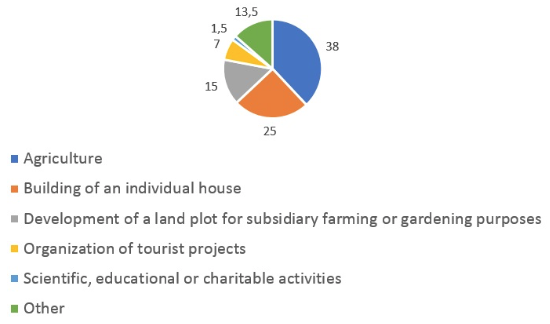
Thus, the data reflected in Figure 2 show that most program participants are planning to conduct agricultural business or build their own house with an adjacent garden on the farm on the received land plots.
Now we are going to analyze how such strategic directions of the development of private entrepreneurship correlate with the general trends of economic development in Russia.
On the one hand, according to the Prime Minister of the Russian Federation D.A. Medvedev, revenue arising from the sale of agricultural products is going to catch up with that arising from the export of hydrocarbon fuels (Medvedev: Russia earned more from grain exports than from weapons, 2015). Besides, the agricultural industry is important for the country due to the following reasons:
On the other hand, the process of agricultural development in Russia is currently facing a few problems:
The share of agricultural industry in the national economy is very low, which attests to the growth potential possessed by this industry, including growth resulting from agricultural development of the Far Eastern hectares (Figure 3).
Figure 3
The share of the agricultural
industry in the economy of Russia
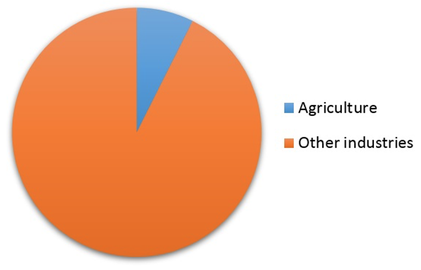
This brings up the following questions: are the territories distributed among participants of the “Far Eastern hectare” program suitable for their purposes and what are the general prospects for their agricultural development?
Opinions of agribusiness specialists about these issues are divided. Some participants point out the fact that land plots received by potential entrepreneurs within the program are not southern fertile territories where virtually anything can be grown. From the perspective of crop farming, the Far East is quite a difficult region: low temperatures are common in many territories, which leads to frostbitten soils; overall, the climate in this region is unstable (Ksenofontova, 2012). Surely, there are certain regions with more favorable conditions (for example, territories along the Amur river), and, according to the official data illustrated by Figure 4, land plots in Amur Krai are in demand among the applicants:
Figure 4
Breakdown of applications for the receipt of the Far
Eastern hectare by geographical location of land plots
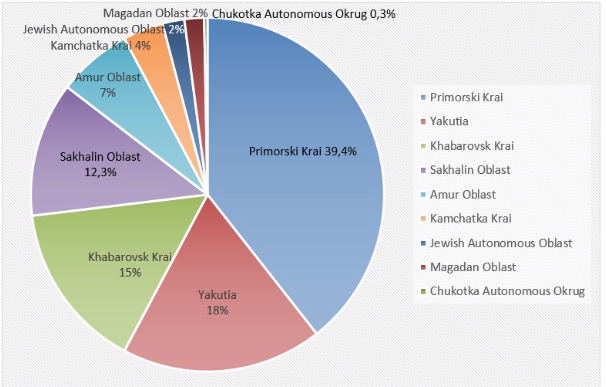
However, the labor input and costs of goods produced on land plots along the Russian shore of the Amur river will remain higher than equivalent parameters of the cheaper goods produced in neighboring China (Bezdudnaya, Fraimovich, 2016).
On the other hand, on the official website of the program, one can find several effective business projects in the agricultural sphere. In addition, on this website, one can enroll in a collective application for setting up eco-settlements — alternative settlements based on collective farming communities.
Another burning issue is financial support provided by the government. On the above-mentioned website, such support measures as subsidized mortgage, various benefits and assistance in job search are mentioned.
Startups receive one-off financial support when an entrepreneur registers as a legal entity or an individual entrepreneur, which amounts to 2,000 to 10,000 rubles. Besides, throughout the first two years of operation, the tax rate for new companies is zero per cent, which is also a form of government support.
The overall picture of support provided to the Far Eastern settlers looks positive. Considering many fulfilled applications for the receipt of land plots, the total sum of financial help provided to program participants as of June 2018 amounted to 252 mln rubles (Figure 5).
Figure 5
Amounts of government funds allocated for financial support of the “Far Eastern hectare”
program and the number of people who received such support in different regions of the
Russian Federation
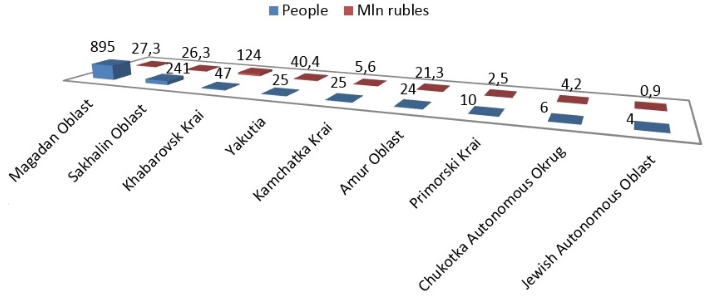
That said, if one considers the amount of funds allocated for the support that was provided to each individual participant of the program rather than the total funding amounts, such financial support will look like an additional insignificant allowance on top of the large capital investment made by the individual.
Indeed, if an unemployed person moves to the Far East, they will receive a one-off settling-in allowance amounting to one to five unemployment benefits, so the total sum can vary from 4.9 to 24.5 thousand rubles (Bezdudnaya et al., 2018).
According to information provided by program participants, at the present time, assistance in job search consists only in the offer to apply for jobs posted on the website (Agency For The Development Of Human Capital In The Far East, n.d.) or submit a CV to a resident company of a PDA. However, participants note that the number of vacancies is no higher than several dozens, while the number of applications for the receipt of land plots exceeds 115,000, out of which over 45,000 have been approved (Figures 6 and 7) (Ksenofontova, Bezdudnaya, Kadyrova, 2017).
Figure 6
The total number of applications for the receipt of a Far
Eastern land plot (115,000) and its breakdown by region
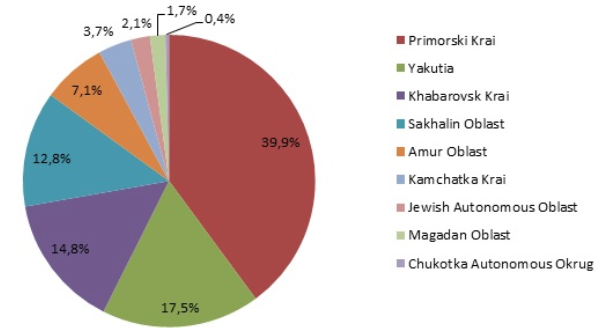
-----
Figure 7
The number of land plot owners according to fulfilled applications (46б000) and their regional breakdown.
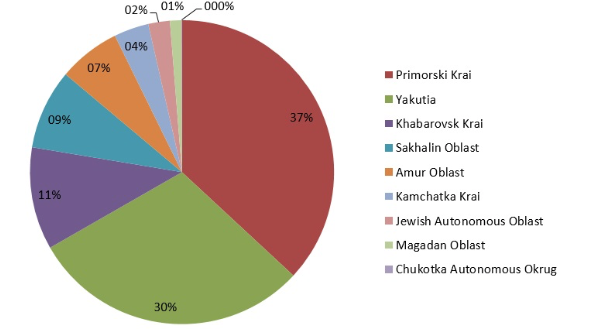
Meanwhile, even excluding the necessary investments in starting a new business, about 3–5 mln rubles is required to build a house, and 2 mln rubles more — to buy an off-roader.
In this connection, we believe that it is important to direct the attention of citizens who have applied for the receipt of a Far Eastern hectare to the opportunity for potential entrepreneurs participating in the “Far Eastern hectare” program to be included in the system of social entrepreneurship.
In conclusion, we suggest the key directions for the development of the “Far Eastern hectare” program, which should be followed in the future in order to increase the efficiency of its practical implementation. It is necessary to:
a) attracting small and medium-sized businesses to the region so that they provide the necessary services to the settlers;
b) attracting young people to participation in the “Far Eastern hectare” program (for example, organization of internships in the “Far Eastern hectares” introduced by higher education institutions; spreading the positive experience of territory development by creating research and practice projects and business plans by students of specialized higher education institutions, including more active practice of suggestion of topics of their pre-graduation practical training and graduation theses. Under this approach the program will improve the demographic situation due to the opportunity for young people to solve the housing problem, which will arise as a result of creation of fully functional towns for youth — development of an agglomeration system out of structural elements represented by satellite towns around PDAs, within which an extensive infrastructure is created).
4) introduce an amendment to the Federal Law no. 119 FZ about the provision of additional territories to the Far Eastern hectare owners if they have developed their plots successfully since the “Far Eastern hectare” program has proved its significance as real support for entrepreneurship and the process of territorial development.
These measures are necessary to increase the level of attractiveness of the “Far Eastern hectare” program and speed up the process of its implementation as a tool of solving main problems faced by the FEFD, including accelerated development of entrepreneurship among ordinary citizens of Russia on the received land plots. Otherwise, as it was stated above in the hypothesis of the research, it is possible that the main settlers in the Far Eastern territories under the Federal Law no. 119 FZ will be oligarchs with newly built houses on the shores of rivers and lakes.
Agency For The Development Of Human Capital In The Far East. (n.d.). We help employers in the Far East to attract qualified personnel. https://hcfe.ru/
Bezdudnaya, A. G., Fraimovich, D. Y. (2016). Diagnostika Effektivnosti Investitsii V Vosproizvodstvennykh Protsessakh Regionalnykh Innovatsionnykh Sistem [Diagnostics of Investment Efficiency In Reproduction Processes Of Regional Innovative Systems]. Konkurentosposobnost v globalnom mire: ekonomika, nauka, tekhnologii, 7–1(19), 35–39.
Bezdudnaya, A. G., Ksenofontova, T. Y., Razumovsky, V. M., Zinchik, N., Iudin, D. S. (2018). Evaluation of Youth Competence in The Field of Sustainable Development: Lifecycle Approach. Espacios, 39(21). http://www.revistaespacios.com/a18v39n21/a18v39n21p05.pdf
Bezdudnaya, A. G., Loginov, A. N. (2018). Rol kommunikatsionnoi infrastruktury v innovatsionnoi deyatelnosti regiona [The role of communications infrastructure in the innovative activity of a region]. Biznes. Obrazovanie. Pravo, 1(42), 19–24.
Bezdudnaya, A. G., Smirnov, R. V. (2017). Sovershenstvovanie Metodov Upravleniya Kachestvom Innovatsionnykh Proektov Promyshlennykh Predpriyatii Na Osnove Otsenki Faktorov Potrebitel''skogo Povedeniya [Improvement Of The Methods Of Quality Management Of Innovative Projects Carried Out By Industrial Enterprises Based On The Assessment Of Customer Behavior Factors]. Vestnik fakulteta upravleniya SPbGEU, 1–2, 20–25.
Bezdudnaya, А. G., Ksenofontova, Т. Y., Rastova, Y., Kraiukhin, G., Tulupov, A. On The Issue Of The Perspective Directions Of The Science-Driven Production Development In Russia. Journal of Social Sciences Research, Special Issue (3), 76-80. https://arpgweb.com/pdf-files/spi3.11.76.80.pdf
Far Eastern hectare. Social initiative of the Government of the Russian Federation. (n.d.). http://надальнийвосток.рф
Federal Law № 119-FZ. (2016). "On peculiarities of providing citizens with land plots in state or municipal ownership and located in the constituent territories of the Russian Federation within the far Eastern Federal district, and on amendments to certain legislative acts of the Russian Federation". http://www.consultant.ru/document/cons_doc_LAW_197427/
Ksenofontova, T. Y. (2011). K voprosu o poluchenii neobkhodimykh prakticheskikh navykov na predpriyatiyakh studentami starshikh kursov rossiiskikh vuzov [On the issue of acquiring necessary practical skills by senior students of Russian higher education institutions at enterprises]. Sovremennye naukoemkie tekhnologii, 1, 141–142.
Ksenofontova, T. Y. (2012). Intellektualnyi kapital proizvodstvennogo predpriyatiya kak kriterii otsenki ego konkurentosposobnosti [Intellectual capital of an industrial enterprise as a criterion for the assessment of its competitiveness]. Vestnik INZhEKONa, Seriya: Ekonomika, 3, 151–159.
Ksenofontova, T. Y. (2013a). Management Of Competitiveness Of The Enterprise By Means Of The Innovative Objects Of Intellektualnry Property Included In Production. Business in Law, 2, 227-230.
Ksenofontova, T. Y. (2013b). Razrabotka Strategii Intellektualnoi Kooperatsii Na Baze Partnerstva Nauki, Biznesa I Gosudarstva [Development of Strategies For An Intellectual Corporation Based On The Partnership Between Science, Business And The State]. Upravlenie megapolisom, 2(32), 98–103.
Ksenofontova, T. Y., Bezdudnaya, A. G., Kadyrova, O. V. (2017). Basic Problems Of Interregional Differentiation In Russia And Innovative And Reproduction Prerequisites To Overcome Them. International Journal of Applied Business and Economic Research, 15(8), 1–10.
Ksenofontova, T. Y., Kocheleva, T. N., Bezdudnaya, A. G. (2016). Тhe interconnection of demographic factors and indicators of the population density in the region territory at the meso-and micro-levels. International Journal of Applied Business and Economic Research, 14(10), 7301–7313.
Medvedev: Russia earned more from grain exports than from weapons. (2015). http://www.trud.ru/article/01-10-2015/1329505_medvedev_na_eksporte_zerna_rossija_zarabotala_bolshe_chem_na_oruzhii.html
Ministry for the development of the Far East. (n.d.). https://minvr.ru/
1. Department of Management and Marketing, Emperor Alexander I St. Petersburg State Transport University, Saint Petersburg, Russia. E-mail: t_yu_ksenofontova@list.ru
2. Department of Management and Innovation, Saint Petersburg State University of Economics, Saint Petersburg, Russia
3. Department of Management and Innovation, Saint Petersburg State University of Economics, Saint Petersburg, Russia
4. Department of Management and Innovation, Saint Petersburg State University of Economics, Saint Petersburg, Russia
5. Department of Management and Innovation, Saint Petersburg State University of Economics, Saint Petersburg, Russia
6. Department of Finance, Credit and World Economy, Sochi State University, Sochi, Russia